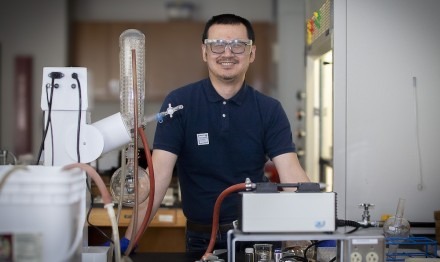Alumna Lands “Dream Job” in KCPD’s Forensics Division

Sometimes there are obvious clues left behind at a crime scene.
Broken glass can indicate a point of entry. Missing items point to a robbery, etc.
But there are less obvious clues, too — things left behind at the molecular level.
That’s where Breez Delarber, ’22, comes in. Shortly after graduating in May with an honors chemistry degree, Delarber made her longtime dream come true when she joined the trace forensics team at the Kansas City Police Department. There she works in KCPD crime lab, analyzing evidence collected at crime scenes to help investigators pursue cases.
“I actually declared my major as a freshman,” she said. “I’ve known since middle school that I wanted to do forensics.”
She said she knew for a while chemistry pointed the way to a career in the field of forensics and worked hard during high school and college to learn all she could. But just as she was starting to look for internships and opportunities to learn in the field, the COVID-19 pandemic struck.
“Internships were suspended, and there weren’t a whole lot of opportunities,” she said. “It was kind of disappointing. I didn’t get to apply for anything.”
The KCPD instituted a hiring freeze, too. But none of it deterred Delarber. She kept working, and with encouragement from her faculty instructors, she continued to seek ways to live out what she sees as her calling.
“Dr. (Annie) Lee, (Ph.D., professor of chemistry) was a huge supporter,” Delarber said. “She was always sending me internship opportunities.”
Rockhurst’s chemistry faculty and coursework also helped her become very comfortable in the lab setting, she said.
“It’s very much independent work,” she said of many upper-level courses. “Being able to work independently and having the confidence that I have in my chemistry skills has really helped me adjust to my career.”
When those job opportunities opened back up, Delarber said she was ready, and began applying for any forensics related jobs. She didn’t get the first one, but the hiring managers told her to keep at it and apply again once she got closer to her graduation date. Eventually, she was hired for a job as an analyst in the trace evidence lab that she began in late May, analyzing the sorts of microscopic pieces of evidence found at a crime scene — “anything that comes up when you put a piece of tape down on a surface,” she says, including hair, paint and dirt. There’s still plenty of learning to do, she said, but she said she would love to be able to tell her younger self that she made it happen.
“This is evidence that could lead to a breakthrough in a case one way or another — it has been a dream come true,” Delarber said. “So many things just aligned to make it happen.”



